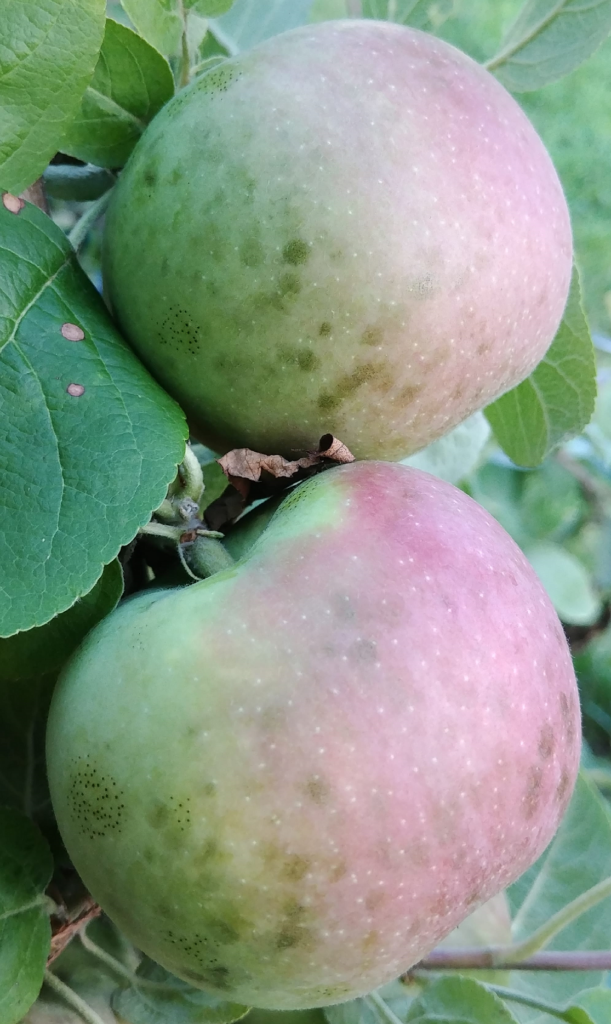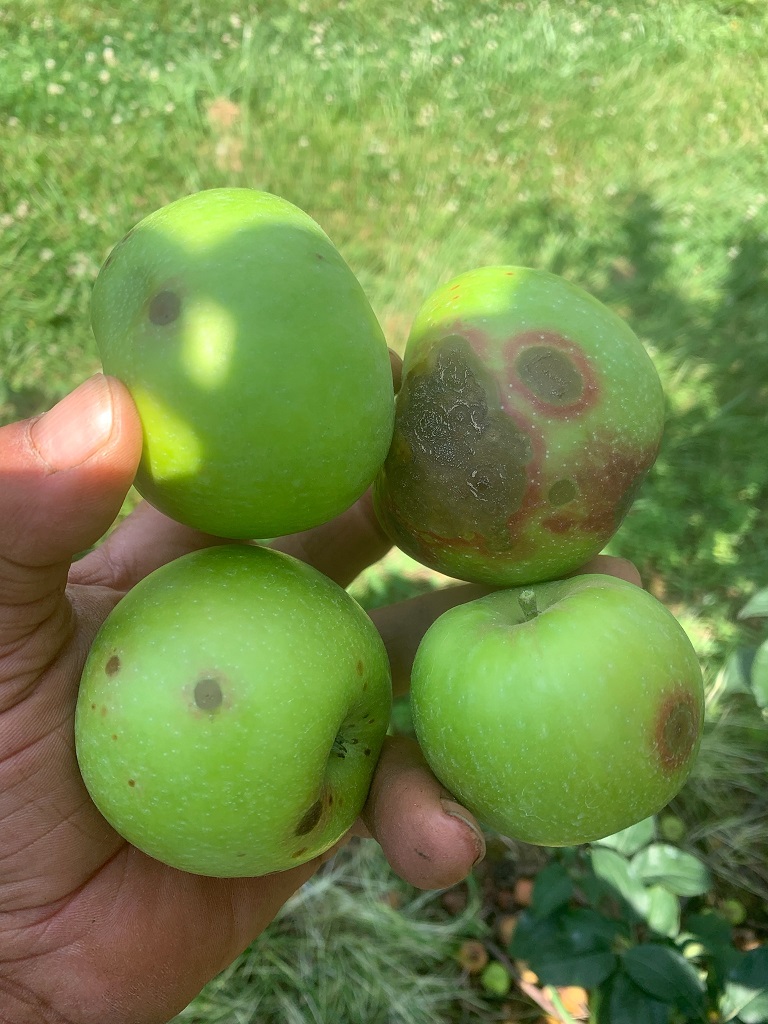1. NEWA Sooty Blotch & Flyspeck (SB&FS) Model Predicts When the First Infections Occur; 2. Fungicide Options for SB&FS and Apple Bitter Rot/Glomerella Leaf Spot

It is that time of the year when we should pay special attention to protecting apple fruit from Sooty Blotch and Flyspeck (SB&FS) in Figure 1 above and apple bitter rot/Glomerella Leaf Spot (Figure 2 below). SB&FS are caused by a large group of fungi which grow superficially on waxy cuticle of apple fruit. Usually, flyspeck caused by Zygophiala jamaicensis shows first and then the sooty blotch appears, which is caused by a complex of species including Schizothyrium spp. Besides cosmetic issues that will reduce the price of apples, sooty blotch can also shorten fruit storage life because it allows increased water loss. Apple bitter rot (Fig. 2) is caused by six Colletotrichum species of fungi: C. fructicola , C. chrysophilum, C. siamense, C. theobromicola, C. fioriniae and C. nymphaeae.

We use an assumption that there is a reduced risk from SB&FS disease between petal fall (PF) and the time until an orchard accumulates 190 hours of accumulated leaf wetness hours (ALFW) counting these hours from First Cover (First Cover is 10 days after petal fall) and using NEWA data for your specific location. Looking for the AREC Winchester weather station data, NEWA’s SB&FS prediction model linked here: Sooty Blotch & Flyspeck is now showing that with the rains we got in recent past, we have passed the 190 h ALWH on 14 May. This calls for looking at the SB&FS model in NEWA’s website for your location daily to determine how close you are before reaching 190 ALWH, so as to apply an effective fungicide mix just before you reach 190 ALWH. Since you have already started applying cover sprays, with first cover starting 10 days after petal fall, knowing when SB&FS fungi infect first time allows you to add in the tank mix materials highly effective against this disease. You also have an option to put in the date of your last fungicide application in the NEWA SB&FS model and this will re-calculate the days of ALWH and give you a new prediction when you need to apply fungicide for SB&FS. Reaching the 190 h ALWH will allow abundant flow of SBFS spores into apple orchards from surrounding woodlots or forests. The spores are coming from near-orchard vegetation in hedgerows and forest trees lots where the SBFS fungi overwinter on the waxy cuticle of canes, shoots, twigs, fruit and leaves of large number of inoculum reservoir plant hosts. From there, SBFS spores are spread to apple fruit by wind or wind borne rain aerosol drops. In a year like 2024, due to enough rain we had recently, SB&FS infections can start infecting fruit as early as 2-3 weeks after petal fall. Symptom occurrence after infections are initiated is dependent on environmental factors and can take place for several weeks to months later.
Be proactive in use of NEWA’s SB&FS model to not surpass the 190 hr of accumulated wetting from first cover. Just before the weather forecast predicts you will reach the 190-hr of accumulated leaf wetting from fist cover, start your SB&FS spray program. We are lucky to know that most fungicides that control apple bitter well are also effective against SB&FS. After you start(ed) your SB&FS program, one cover spray is worth: 14 days or 2 inches of rain, whichever comes first. In commercial orchards, we have to make sure that there is almost always enough fungicide residue to prevent SB&FS. My recommendation to use at 2nd and 3rd cover would be:
Captan 3 LB/A + Inspire Super 12 fl.oz./A or
Captan 3 LB/A + Prophyt** 64 fl.oz./A or
Captan 3 LB/A + Topsin M** 1 lb/A or
Captan 2.5 – 3 LB/A + Ziram 6 lb/A or
Captan 3 LB/A or
Ziram 6 lbs/A
At 4th and 5th cover, which should be now i.e. at the end of May, I would recommend the following tank mix which would be effective for SB&FS, Marssonina Leaf Blotch, and bitter rot/Glomerella Leaf Spot (high pressure for infection by bitter rot in Virginia starts approximately at end of May to beginning of June):
Aprovia 5.5 – 7 fl oz (30 PHI) + Captan 80 WDG 3 lb
Then, for 6th and 7th cover spray should/could be done with this tank-mix:
Omega 13.8 fl oz (28 PHI) + Captan 80 WDG 3 lb.
Other fungicides like QoI-s: Flint Extra, Luna Sensation, Pristine and Merivon, are the most effective against SB&FS and apple bitter rot/Glomerella leaf spot and should always be combined in a tank with captan. Depending on when you will harvest your apples (early vs. late maturing cultivars) you can go up to 8th or 12th cover spray. For early maturing cultivars (last fungicide applied at 7th to 9th cover) finish the growing season with applying to last cover two sprays with Merivon 5.5 fl oz + Captan 80 WDG 3 lb. If you have late maturing cultivars, requiring extended spray covers until harvest, use the following tank mixes (you must read and implement the Pre-Harvest Interval /PHI/ listed on the labels for all these fungicides before you apply them so as to not violate the PHI restrictions)*:
8C: Pristine* 14.5 oz + Captan 80 WDG 3 lb or Flint Extra* 2.9 fl oz/A + Captan 80 WDG 3 lb
9C: Captan 80 WDG 3 lb
10C: Merivon* 5.5 fl oz + Captan 80 WDG 3 lb
11C: Captan 80 WDG 3 lb
12C: Merivon* 5.5 fl oz + Captan 80 WDG 3 lb
Fruit Harvest
OR
8C: Luna Sensation* 5.8 fl oz + Captan 80 WDG 3 lb or Flint Extra* 2.9 fl oz/A + Captan 80 WDG 3 lb
9C: Captan 80 WDG 3 lb
10C: Merivon* 5.5 fl oz + Captan 80 WDG 3 lb
11C: Captan 80 WDG 3 lb
12C: Merivon* 5.5 fl oz + Captan 80 WDG 3 lb
Fruit Harvest
*WARNING: do not apply more than 4 applications of Group 11 fungicides also known as QoI fungicides per growing season. Flint Extra, Luna Sensation, Pristine and Merivon all belong to this same group 11 fungicides meaning that they all have the same single-site mode of action against Colletotrichum species which cause apple bitter rot/Glomerella leaf spot. Therefore you should limit their use as a group to only 4 applications per season. This will prevent high risk for causing QoI-fungicide resistance which leads to loss of Group 11 fungicide efficacy. You can see above I made sure that this happens and I also recommended you to implement two new fungicides: Aprovia and Omega that are effective against apple bitter rot/Glomerella leaf spot but have different modes of action from Group 11 fungicides. That will help reduce selection pressure that extensive use of Group 11 fungicides creates.
